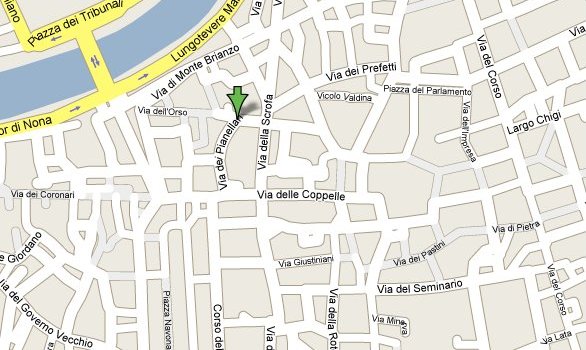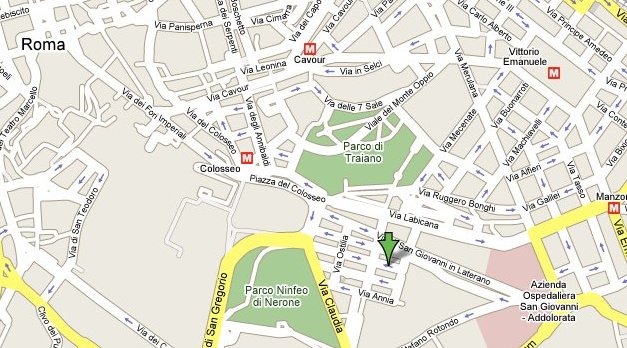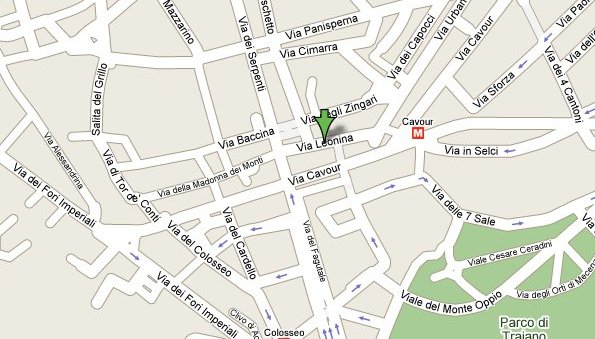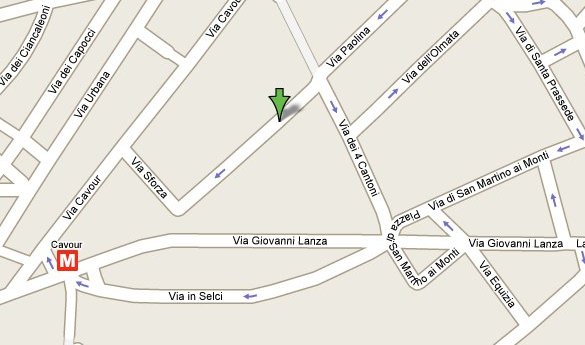Hotels in Rome
Introduction
This is a web page made up of my notes from researching hotels in Rome
for a trip in the spring of 2007. The hotels below are 2 to 3 star
hotels. I will be traveling alone, so my concentration is on
camera singola (a single room). My preference is also for
small hotels. Ideally I'd also like to find a hotel that has an
in-room high speed (DSL) Internet connection. This allows me to down
load my pictures to bearcave.com and avoid the security risks of an
Internet cafe. I only consider booking hotels where I can book
directly through the hotel. I'm nervous about booking through the
booking services, since they add an extra layer where things might go
wrong. Also they are taking a cut of the money, so the hotel may not
give you the best room for the money you're spending. All of the
hotels here have web pages and, even for promising hotels, I skipped
them if they do not have Web pages and email contact information.
Rome is a remarkably expensive city. It is said that Venice is one of
Italy's most expensive cities, but Rome seems to be more expensive.
It is difficult to find a nice single room for much less than €
140.
The references I have used are:
-
Sandra Gustafson's Great Sleeps Italy: Florence, Rome, Venice,
Fourth Editon, 2002, Chronicle Books
-
The Rough Guide to Rome, Second Edition
-
The map screen shots are from Google maps.
I also check the reviews on TripAdvisor, which I have found
to be an invaluable resource.
I have listed the areas of Rome in order of what I consider desirable
(without having visited Rome yet). The most desirable areas are
listed near the top of the web page, the least desirable toward the bottom
of the page.
The Centro Storico (Piazza Navona and the Pantheon)
The Rough Guide to Rome, Second Edition, describes this area as
(UK spelling is theirs):
The real heart of Rome is the centro storico or "historic
centre", which makes up the grater part of the roughly triangular
knob of land that bulges into a bend in the Tiber, above Corso
Vittorio Emanuele II and to the west of Via del Corso,
Rome's main street. This area, known in ancient Roman times as the
Campus Martinus, was outside the ancient city centre, a low-lying area
that was mostly given over to barracks and sporting arenas, together
with several temples, including the Pantheon. Later it became
the heart of the Renaissance city, and nowadays it's the part of the
town that is densest in interest, an unruly knot of narrow streets and
alleys that holds some of the best of Rome's classical and Baroque
heritage and it's most vivacious street - and nightlife. It's here
that most people find the Rome they have been looking for - the Rome
of small crumbling piazzas, Renaissance churches and fountains, blind
alleys and streets humming with scooters and foot-traffic. Whichever
direction you wander in there's something to see; indeed it's part of
the appeal of the centre of Rome that even the most aimless ambling
leads you past some breathlessly beautiful and historic spots.
-
Hotel
Portoghesi
Via del Portoghesi, 1
00186 Rome
Tel: +39 006864231
€ 150 for a single.
The web site does not mention whether this
includes breakfast, but Great Sleeps states that a buffet
breakfast is included.
The hotel has WiFi/ADSL internet.
The TripAdvisor.com reviews
of Hotel Portoghesi are universally good. The hotel staff is
reported to be friendly and helpful. The hotel is located in a quiet
area, but centrally located near many of the important sights in rome.

-
Albergo Santa
Chiara
Via Santa Chiara, 21
00186 Roma
Tel: +39-066 872 979
€120 to €150 for a single
The Albergo Santa Chiara is one of the larger hotels listed in
Great Sleeps Italy, with 98 rooms (of which there are 12
singles). According to Great Sleeps the hotel has many
impressive antiques. However, they do not seem to provide Internet
access.
The Albergo Santa Chiara is recommended in a number of travel guides,
including Great Sleeps Italy. Everyone mentioned the fantastic
location. Perhaps the popularity has "gone to their head". The hotel
has been run by the same family for over 200 years, so perhaps they
consider themselves to be hotel aristocracy. The TripAdvisor.com reviews
of the Albergo Santa Chiara are generally good. However, enough
guests commented that the staff are not very friendly and not always
helpful that this is something to consider before booking this hotel.
Ancient Rome (the Colosseum and the Forum)
The Rough Guide to Rome, Second Edition, describes the Ancient Rome
area as:
Ancient Rome is the area that stretches south east from the
Capitoline Hill. It's a reasonably traffic-free, and self-contained,
part of the city. But it wasn't always like this: Mussolini ploughed
Via dei Fori Imperiali through here in the 1930s with the idea
of turning it into one massive archeological park...
Ancient Rome includes the Colosseum, the Imperial Forums, the
Palantine Hill and the Celian Hill.
-
Hotel Lancelot
Via Capo D'Africa 47
00184 Rome, Italy
Tel +39 06 7045 0615
€110 for a single with breakfast
Compared to most of the hotels on this web page, this is a large
hotel, with 60 rooms. Despite the corny name, the Hotel
Lancelot has rave
reviews on TripAdvisor. At the time I wrote this there were 156
reviews and the average review score was 4.5 out of 5, which is
spectacular. Especially when you consider that there are always those
who expect a five star hotel at three star prices who usually bring
down the average.
The hotel is generally tastefully decorated. According to Small
Hotels dining is family style in the morning and evening. As a
single traveler this sounds nice because you get to talk to people.
Apparently the hotel is owned by an British expatriate, Mrs. Khan.
There is a "half board" option where you get breakfast and dinner.
The dinner prices are very reasonable, however, the food and wine
sound somewhat basic.
The single room number 66 is supposed to be nice, with a view of the
Colosseum.
The hotel has WiFi Internet access.

-
Hotel Fori Imperiali-Cavalieri
Via Frangipane, 34
00184 Roma, Italy
Tel. +39 - 06 6796246
€85 to €130 for a single
The photographs of the hotel on-line suggest that the hotel is
tastefully decorated. The hotel is located near the Colosseum in ancient
Rome. The rooms have cat-5 Internet and there is WiFi available. The
room rate not only includes breakfast, but also an aperitif.
The TripAdvisor reviews
of Hotel Fori Imperiali-Cavalieri reviews mention that the
hotel is not quite as charming in person as the Internet photos
suggest. The hotel is described as a good, basic hotel in a great
location. The hotel is listed as three stars, but it sounds a bit
like a two star hotel.
-
Hotel
Duca D'Alba
Via Leonina, 14
Rome, Italy 00184
Tel: +39 06484471
€70 to €210 for a single
The decor of Hotel Duca d'Alba is tasteful and modern. The rooms
have cat-5 internet jacks. The hotel is located in the the ancient
Roman district known as Suburra a few minutes walk from the
Fori Imperiali, the Coliseum and the Piazza Veneza. The hotel is near
the Cavour metro stop.
The TripAdvisor
reviews are generally good (a number of 4 out of 5 and 5 out of 5
reviews). But one disturbing comment by someone who stayed at the
hotel in October 2006 was:
The other odd thing was when it came time to pay, we tried to pay by
credit card, but the guy at reception told us that the 170/night was a
cash deal (though they never told us that), and if we wanted to pay by
visa it would cost 195 Euros/night.
I don't know what to make of this. I did not see this in other
comments. I am planning to stay seven or eight nights. It would be a
major problem if they wanted me to pay in cash or insisted in charging
me twenty Euros a night more for using a credit card.

-
Hotel
Colosseum
Via Sforza, 10
Roma, Italy 00184
Tel: +39 064827228
€105 to €128 for a single.
From the web page:
The Hotel Colosseum is located in the centre of Ancient Rome in
a quite street, between the Cathedral of St. Mary Major and the
Coliseum, near the main train station Termini and the Domus Aurea. The
hotel is located in one of the highest points of the Esquilino Hill
and thanks to it's very pleasent terrace gives to it's clients an unic
opportunity to join a wonderful panoramic view of of all Rome and
environs.
By the reception it's possible to have all
informations regarding sightseen tours, taxi and bus; cars, bikes and
scooters rental. The common areas of the hotel are covered with
internet wi-fi connection.
The nearest metro stop ("Cavour") is at three minutes walking like the
Opera House that is around 10 minutes.
The decry tends toward heavy furniture and dark wood. I assume that
in reference to this style of decorating the author of Great
Sleeps describes the dining room as "medieval".

Campo de' Fiori
The Campo de' Fiori area is part of Rome's ancient city. The
Campo de' Fiori area lies between the Corso Vittorio Emanuel II
(the huge white marble monument to King Vittorio Emanuel II, who was
the king during Italian unification in 1860) and the Tiber River. The
Rough Guide to Rome, Second Edition, gives this description for
the Campo de' Fiori area:
It's a very similar neighbourhood [to Rome's Centro Storico
area], the same cramped, wanderable streets opening out onto small
squares flanked by churches, although it's more of a working quarter =
less monumental, with more functional buildings and shops, as
evidenced by it's main focus, Campo de' Fiori, whose fruit and
veg stalls and rough-and-ready bars form a marked contrast to the
pavement artists and sleek cafes of Piazza Navona. Across the river
to the west lies the Vatican and to the south Trastevere... To the
east it merges into the gloomy streets and scrabbly Roman ruins of the
Old Jewish Ghetto, a small but atmospheric neighbourhood that
nuzzles up close to the city's giant central synagogue, while just
north of here lies the major traffic intersection and ancient Roman
site of Largo di Torre Argentina.
[emphasis in the original]
-
Hotel Teatro Di
Pompeo
Largo del Pallaro, 8
Roma, Italy 00186
Tel: +39 066872812, +39 0668300170
€130 to €150 for a single. No internet.
This 16 room hotel is centrally located in the ancient part of Rome.
The Hotel takes it's name from Pompey's Theater, which was built by
the Roman consul Pompey, who fought in the civil war against Caesar.
Pompey was, in his time, a great general and amassed a great fortune
from looting the countries he conquered. He used some of this to
build the theater.
The rooms are nice and the hotel is located within walking distance of
many of the attractions of classical Rome.
The TripAdvisor reviews
of Hotel Teatro di Pompeo are very good (four our of
five).

Vatican
-
Hotel Alimandi
The Hotel Alimandi is only a block from the entrance of the Vatican.
However, the web site is entirely unhelpful. No listing of the hotel
rates, nothing about what comes with a room (e.g., is there Internet
access).
The TripAdvisor.com reviews
are almost universally good. Out of 63 reviews, the only "1 star"
reviewer wrote (in May 2006):
A tour bus had come in with extra people so they gave away my room. He
told me he had a solution and took me across the street to an
apartment and told me we could stay there. Great except that his
brother emerged in a bath robe and we were told he would be there
during our visit. We walked the neighborhood and wound up at the
Spring House. Never again! Only in Italy.
Tridente: Piazza di Spagna (the Spanish Steps)
Again, quoting the Rough Guide to Rome, Second Edition's
description of this area (note that this is a UK publication and
follows British spelling):
The northern part of Rome's city centre is sometimes known as
Tridente due to the trident shape of the roads leading down
from the apex of Piazza del Popolo - Via del Corso in the centre, Via
di Ripetta on the left and Via del Bubuino on the right. The area
around Piazza di Spagna especially is traveler's Rome,
historically the artistic quarter of the capital, for which
eighteenth - and nineteenth - century Grand Tourists would make in
search of the colourful, exotic city. This part of the city has also
always had an artistic feel: Keats and Giorgio de Chirico are just two
of those who used to live on the Piazza di Spagna; Goethe had lodgings
along Via del Corso; and places such as Caffe' Greco and
Babington's Tea Rooms were meeting-places of a local artistic
and expat community for close on a couple of centuries. Today these
institutions have given ground to more latter-day traps for the
tourist dollar: American Express and McDonald's have settled into the
area, while Via Condotti and around is these days strictly
international designer territory, with some of Rome's fanciest stores;
and the local residents are more likely to be investment bankers than
artists or poets. But the air of a Rome being discovered, even
colonized, by foreigners persists, even if most of them hanging out on
the Spanish Steps are mostly flying-visit teenagers.
Some comments on TripAdvisor.com noted that the Tridente area has a
lot of expensive and not terribly good resturants aimed at tourists.
Ironically, some people from the UK commented that meals were just as
expensive as they were back in the UK. Apparently they have not
noticed that Italy in the era of the euro is at least as expensive as the
UK (or the US). This is a district where you are likely to find lots
of tourists, as the Rough Guide description suggests. I'm not
actually sure why people choose to stay in this area. It sounds like
the San Marco area in Venice.
-
Hotel
Fontanella Borghese
Largo Fontanella Borghese, 84
00186 Roma
Tel +39 06/68809504, +39 06/68809624
€120 to € 175 for a single. They do not state whether or
not this includes breakfast.
The Hotel Fontanella Borghese has a very sparse web page that
simply lists rates, contact information and directions, along with a
few photographs. They do not mention Internet access. Rooms facing
the interior courtyard are recommended because they are quieter.
The TripAdvisor.com reviews range from OK to very good.
-
Albergo Internazionale
Via Sistina, 79
00187 Rome, Italy
Tel: +(39) 066 994 1823
€120 to € 180 for a single
The Hotel Internazionale (Albergo Internazionale) has WiFi
Internet access.
This hotel is listed in Great Sleeps Italy. However, the
Albergo Internazionale got very
mixed reviews on TripAdvisor.com. Some people loved the hotel and
others hated it. One guest, who stayed at the hotel in October 2006
writes: "We stayed there for 4 wonderful days and all of us enjoyed it
very much. The staff of the hotel was very friendly and helpful. If
ever in Rome I suggest this hotel to everyone." Another guest, who
stayed at the hotel in April 2006 wrote "The pictures of the rooms, on
the internet, look far more nicer than the actual rooms!! Over all,
ruined our vacation in Rome!!".
-
Hotel Pensione Parlamento
I could not find a web site for the Hotel Pensione Parlamento
The reviews
on TripAdvisor are generally good or excellent, with a few "OKs".
Some commented that the breakfast was not very good and that they
served American style "think truck stop" coffee.
My main web page on Italy
back to home page





